10-year mortgage refinance rates hold steady in bargain territory, rates for other terms rise | Oct. 6, 2021
Our goal here at Credible Operations, Inc., NMLS Number 1681276, referred to as "Credible" below, is to give you the tools and confidence you need to improve your finances. Although we do promote products from our partner lenders, all opinions are our own.

Check out the mortgage refinancing rates for Oct. 6, 2021, which are mostly up from yesterday. (iStock)
Based on data compiled by Credible, current mortgage refinance rates are mostly up compared to yesterday’s, except for 10-year rates, which remained unchanged.
- 30-year fixed-rate refinance: 3.000%, up from 2.940%, +0.060
- 20-year fixed-rate refinance: 2.750%, up from 2.625%, +0.125
- 15-year fixed-rate refinance: 2.250%, up from 2.125%, +0.125
- 10-year fixed-rate refinance: 2.125%, unchanged
Rates last updated on Oct. 6, 2021. These rates are based on the assumptions shown here. Actual rates may vary.
Mortgage refinance rates rose across three terms since yesterday. While refinance rates remain low overall, this upward trend could be the start of rate increases that experts have predicted will happen before the year’s end. Homeowners who want to save on interest and can swing a higher monthly payment can find a bargain with a 10-year refinance. Rates for this term have held steady at 2.125% for the past four days.
If you’re thinking of refinancing your home mortgage, consider using Credible. Whether you're interested in saving money on your monthly mortgage payments or considering a cash-out refinance, Credible's free online tool will let you compare rates from multiple mortgage lenders. You can see prequalified rates in as little as three minutes.
Current 30-year fixed refinance rates
The current rate for a 30-year fixed-rate refinance is 3.000%. This is up from yesterday. Refinancing a 30-year mortgage into a new 30-year mortgage could lower your interest rate, but may not have much effect on your total interest costs or monthly payment. Refinancing a shorter term mortgage into a 30-year refinance could result in a lower monthly payment but higher total interest costs.
Current 20-year fixed refinance rates
The current rate for a 20-year fixed-rate refinance is 2.750%. This is up from yesterday. By refinancing a 30-year loan into a 20-year refinance, you could secure a lower interest rate and reduced total interest costs over the life of your mortgage. But you may get a higher monthly payment.
Current 15-year fixed refinance rates
The current rate for a 15-year fixed-rate refinance is 2.250%. This is up from yesterday. A 15-year refinance could be a good choice for homeowners looking to strike a balance between lowering interest costs and retaining a manageable monthly payment.
Current 10-year fixed refinance rates
The current rate for a 10-year fixed-rate refinance is 2.125%. This is the same as yesterday. A 10-year refinance will help you pay off your mortgage sooner and maximize your interest savings. But you could also end up with a bigger monthly mortgage payment.
You can explore your mortgage refinance options in minutes by visiting Credible to compare rates and lenders. Check out Credible and get prequalified today.
Rates last updated on Oct. 6, 2021. These rates are based on the assumptions shown here. Actual rates may vary.

These rates are based on the assumptions shown here. Actual rates may vary.
Think it might be the right time to refinance? Be sure to shop around and compare rates with multiple mortgage lenders. You can do this easily with Credible and see your prequalified rates in only three minutes.
Rates last updated on Oct. 6, 2021. These rates are based on the assumptions shown here. Actual rates may vary.
What are the different types of refinancing?
Refinancing your mortgage basically means you take out a new mortgage to pay off your current home loan. But your reasons for wanting to refinance can affect the type of mortgage refinance you choose.
Here are four types of refinancing to consider.
Rate and term refinance
This type of refinance is probably what many people think of when they consider refinancing their mortgages. As the name implies, a rate and term refinance changes the rate, repayment period — or both — of your current mortgage by paying it off and replacing it with a new mortgage. With a rate and term refinance, you would borrow exactly the amount you need to pay off your current mortgage.
Cash-out refinance
Like a rate and term refinance, a cash-out refinance may change the rate, term or both. But with this type of refinance, you borrow more than you need to pay off your current loan and take that balance as cash. This is only possible if you have sufficient equity built up in your home.
Cash-in refinance
As with other types of refinancing, a cash-in refinance replaces your current mortgage with one that has a different interest rate and/or term. But for your new loan, you’ll also make a lump sum payment to reduce the principal balance on your new mortgage. Of course, if you have the money to make a lump sum payment, you could just pay extra toward the principal on your current loan. But making this payment in connection with a refinance allows you to reap the interest savings that can come with refinancing.
FHA streamline refinance
This type of refinancing is only available for people who have FHA mortgages. It offers the same basic benefits as other types of refinancing but requires less paperwork. Some limitations apply. For example, you can’t be behind on your current mortgage, and you can’t cash out more than $500.
How to get your lowest mortgage refinance rate
If you’re interested in refinancing your mortgage, improving your credit score and paying down any other debt could secure you a lower rate. It’s also a good idea to compare rates from different lenders if you're hoping to refinance so you can find the best rate for your situation.
Borrowers can save $1,500 on average over the life of their loan by shopping for just one additional rate quote, and an average of $3,000 by comparing five rate quotes, according to research from Freddie Mac.
Be sure to shop around and compare rates from multiple mortgage lenders if you decide to refinance your mortgage. You can do this easily with Credible’s free online tool and see your prequalified rates in only three minutes.
How does Credible calculate refinance rates?
Changing economic conditions, central bank policy decisions, investor sentiment and other factors influence the movement of mortgage refinance rates. Credible average mortgage refinance rates are calculated based on information provided by partner lenders who pay compensation to Credible.
The rates assume a borrower has a 740 credit score and is borrowing a conventional loan for a single-family home that will be their primary residence. The rates also assume no (or very low) discount points and a down payment of 20%.
Credible mortgage refinance rates will only give you an idea of current average rates. The rate you receive can vary based on a number of factors.
What are some reasons to refinance?
Each borrower’s situation is different, but here are some good reasons to refinance:
- To get a lower interest rate — A lower interest rate could mean you pay less in interest over the life of your mortgage — provided you also refinance into a shorter term.
- To shorten the repayment period — If your ultimate goal is to be mortgage-free one day, shortening the repayment period could help that happen sooner.
- To reduce interest costs over the life of the loan — Interest can be a significant chunk of the total cost of your mortgage. For example, if you borrow $250,000 at 3.5% for 30 years, your total interest costs would be $154,140. Refinancing at 2.75% for the same repayment period could save you $36,723 in interest costs.
- To withdraw equity in cash — Known as a "cash-out refinance," this type of refinance allows you to take out a new mortgage for more than you owe on your old one and take the difference in cash. Your home’s equity secures the extra cash, which you can use for home improvements, repairs or other needs.
- To get a fixed mortgage rate — If you took out an adjustable-rate mortgage, the very low initial interest rate can reset to a much higher one at the end of the initial period. And after that, your rate can change with market conditions. Many homeowners with ARMs look to refinance into fixed-rate mortgages that can ensure a reliable payment at a predictable rate.
Conversely, some reasons for refinancing are less than great:
- To use equity to pay off unsecured debts like a car loan or credit cards — If your interest rate on those types of credit is high, and you can get a really low mortgage refinance rate, you may think "Why not?" But unsecured debts like personal loans or credit cards, and even a secured auto loan, don’t put your home at risk. Paying off those debts by refinancing your home mortgage turns those unsecured debts into one that’s secured by your home.
- To use equity for investing — Using equity to invest puts your home at risk for something that’s already a risky proposition. Investing comes with no guarantee of returns. Meanwhile, paying off your mortgage and preserving your equity has a reliably positive impact on your credit and finances.
- To use equity for a big purchase — If you have equity built up in your home, it may be tempting to tap it to get cash for luxuries like a big trip, an RV or even cosmetic surgery. But think carefully before you do a cash-out refinance for these reasons. A refinanced mortgage is a long-term debt.
Credible also has a partnership with a home insurance broker. You can compare free home insurance quotes through Credible's partner here. It's fast, easy and the whole process can be completed entirely online.
Have a finance-related question, but don't know who to ask? Email The Credible Money Expert at moneyexpert@credible.com and your question might be answered by Credible in our Money Expert column.
As a Credible authority on mortgages and personal finance, Chris Jennings has covered topics that include mortgage loans, mortgage refinancing, and more. He’s been an editor and editorial assistant in the online personal finance space for four years. His work has been featured by MSN, AOL, Yahoo Finance, and more.

